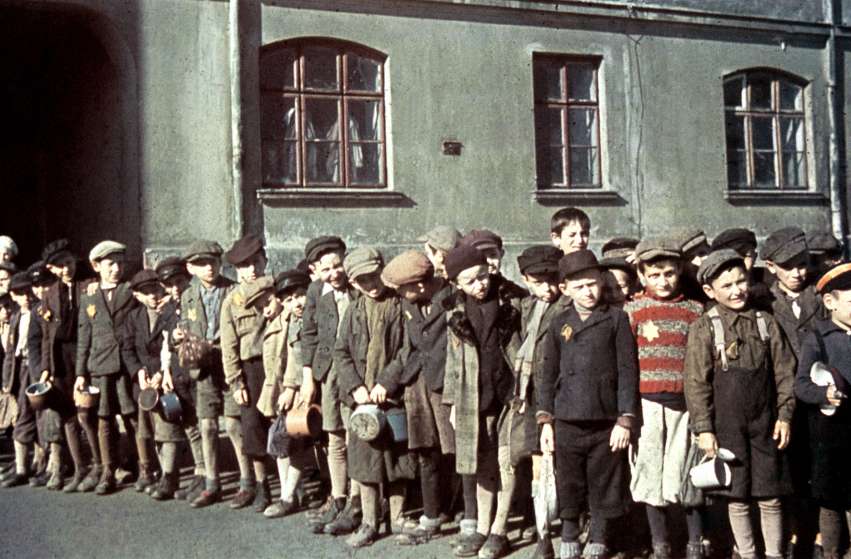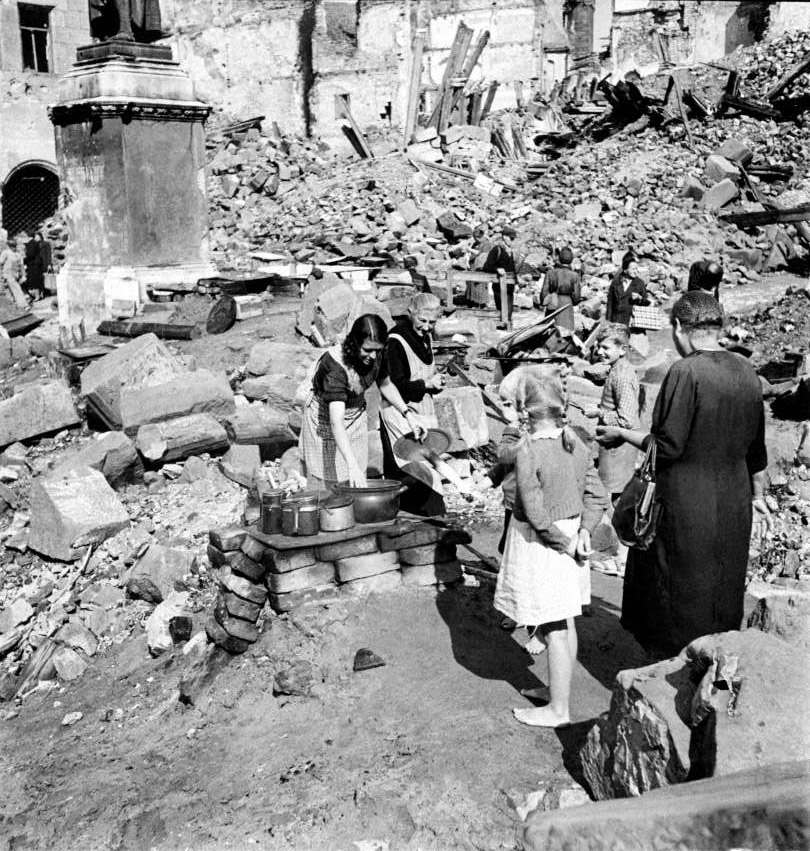Photographic evidence of children and war

Children of Lodsz - the star says everything Collection of Reinhard Schultz
See as well another set of photos under the heading Children and war
Photography can be used as 'imaginary witness'. The philosopher Adorno coined this term when he wondered to whom to entrust important historical evidences, so that the next generations would not repeat doing the same mistakes. For that stories told must make sure to communicate what took really place. The reason for Germany having passed a law to ensure no one denies the existence of the Holocaust during which 6 million Jews perished, is a case in point why such witnesses are needed.
That touches upon a crucial element which does alter the narration once we no longer just read about something but see what took place. A photo is not a film, but can become a part of a series of photos depicting various elements. Hence it can be considered as an elongated moment. It leaves to the imagination further details to be known not only in anticipation as to what would come the very next moment when the photo was taken. Rather in knowing already in general terms the story, the photo adds important details otherwise not noticed when admist the turbulence of things. It is what Ai Wei-wei would say: conciously we perceive in the present only a fraction of what existed simultaneously in that moment when the photo was taken. This enlargement of the present moment allows us to see what we did not see. It is an intangible heritage to which photos give meaning. Substantiated by what the photographer seizes as 'the definining moment', the human element of awareness for something significant enters and makes out of what is taking place something of historical importance. In this interplay space can be given to various meanings and interpretations.

From the Stroop Report
Crucial is what comments can be added as a further going explanation of the context in which it takes place. When Ai Wei-Wei was questioned by professors of the University of Arts in Berlin when making his debut, there was a lead question about one photo which was picked from a stand at a flee market in Berlin. When the professor wanted to ask Ai Wei-wei what he sees when looking at the three figures depicted. he was immediately corrected by Ai Wei-wei who pointed out that there was a fourth figure: the doll which the girl was holding while being in the middle of a man and a woman. The professor added then what was written on the back of the photo: "I had a strained neck and therefore could not look up right into the camera." The woman had indeed her head tilting sharply to one side. Comments like these can be called the flavour of life.
Desolation in life

It is hard to imagine what went through the mind of that girl clutching her doll as if by protecting the doll, she will feel protected herself. Devastation on the ground with everything in tatters suggests a kind of desolation. It is as if one has been abandoned by humanity. The silent crying out is a plea for some sign of reason and compassion. The word 'mercy' could be added to what is after all at stake. For when war tears apart everything, including and fore mostly the family, then this sense of togetherness evaporates like water which has been boiling for some time already and now simply ecapes into thin air. What is so striking about this photo is the look of the girl. It seems to say you would not dare to take away my doll. The life saving device is a reminder of the simple fact that we protect ourselves better by safeguarding the life of others so that no harm comes upon them. Naturally it is a far cry from anything having to do with human compassion. War machines roll through a town and leave behind a scene of utmost destruction left and right.

Hiroshima
Even greater is the force of destruction when an atomic bomb is dropped. Hiroshima and Nagasaki stand for this absolute form of destruction. One wonders about those men who made the decision to force in this way Imperial Japan into capitulation? It is connected to Einstein and what scientific discoveries led to the making of the atomic bomb. There is this critical essay by Bertrand Russell about the fathers of Fascism. In that essay he describes how the discovery made during First World War that technology entails a lot of power over people prompted many highly intelligent men to throw themselves into research. Their sole aim was to make the technology more perfect. Russell adds despite all of them being highly intelligent, there was just one thing wrong with them: "no ethical orientation." It meant giving everything to the increase of power regardless of the consequences.
To describe all that in 2015 means to underline once more the strong points of photography and what alone a moment captured by the lens can tell in terms of a story of what was left for children once the atomic bomb had been dropped for the first time. In Japan this lead in 1995 to the creation of Kids' Guernica and therefore links Hiroshima and Nagasaki to Guernica where bombs were dropped for the first time from the air upon an innocent population in 1937.

Guam

Child soldier
Towards the end of Second World War, Hitler was getting desparate. With many troops having been killed or else taken prisonier, he tried to bloster the Wehrmacht by recruiting young soldiers. This had disasterous consequences for their combinination of naivity and inexperience in war fare meant many of them got killed or else they provoked incidences which jeopardized the entire troop. That could start with just poking out of curiosity the head out of the trenches and immediately granates were thrown from the other side. This underlines that absurd reality for children at war provoke all the time and consequently they demask war as being just absurd. Why should young lives go to waste? A lingering of these war efforts are retained even more so by mothers who think their sons are only then men when in uniform. That absurdity points to how war is being reproduced without really understanding the consequences.

Gas war fare
Andre Malraux described how gas created havoc when used for the first time during First World War. The wind turned and thus both sides were equally affected. So the soldiers dropped their guns and started to run about without knowing anymore into which direction they could flee into safety. Some carried bodies on their back. They did not care whether dead or alive, friend or foe. The twisted logic of war making out of the other an enemy became undone. Amazing this account of Malraux.
During Second World War gas was used on various occasions. A more precise account thereof could be given by historians but the photograph of the boy wearing a gas mask says it all. Once it becomes necessary to wear such a mask, then survival is really at stake. At the same time, the mask transforms the person into quite another figure of speech. The face is no longer recognizable, but also there is no longer any recognition that human beings are still in communication with each other. That may be the case of the elite hiding far away from the battle field in some safe bunker. The deliberate death sentence by use of gas has become a night mare since First and Second World War. Weapons of mass destruction as gas is called, confounded many critics and led to the invasion of Iraq alone on the claim Saddam Hussein was in possession of these weapons. Once politics uses this fear factor to movitate people from going into war, then it can be said the historical experiences with gas as weapon has estranged many from what are no longer calculated risks, but what becomes then an over exaggeration of total destruction insofar it amounts to a call for total determination to fight that fear from gas being used as a weapon. The choking off of air makes that fear plausible, and therefore in the use of propaganda, into a convincing argument for war.

Cooking in the rubbles
Like a little flower growing amidst all the destroyed building, the fact that the women start to cook shows how life continues even under the most difficult circumstances.

The remains of an edifice
No more time to wonder but still the onlookers are amazed what has become of their city. Kükkemeyer developed the thesis that European cities had brought upon themselves this destruction because the way they were built, that was too horrible and ugly. Not surprisingly people of Manchester would express too bad that Hitler did not continue destroying the city for they would have loved to get rid of the old city. Constrained by bad decisions, they were eager to feel free to rebuild the city but not to make the same mistakes. This may be a far fetched interpretation of war brought upon oneself, but after the horrific First and Second World War, many were at loss to explain why these human catastrophies could not have been avoided.
Significantly Hochhut, the playwright, picked up the last entry in the diary of a young soldier who died on the battle fields of Verdun. It said simply: "and I could have prevented the war" by not joining in the first place. Thomas Mann in Zauberberg (Magic Mountain) stated it all started out of boredom which made war appear like a desirable distraction, an adventure, to the daily routine of having to sit behind a desk while it seemed as if life was passing by outside.
Hatto Fischer
22.12.2015
« Reinhard Schultz – Biography | Andreas Lang »
